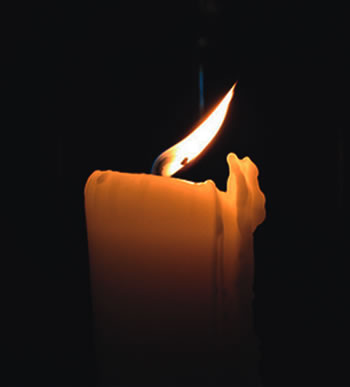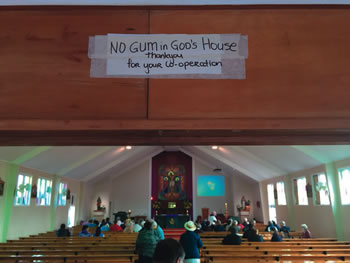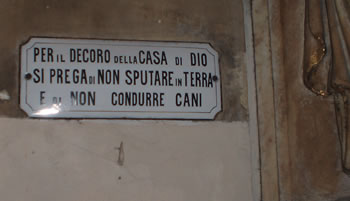Decorum and Liturgy
The Bishops of the Second Vatican Council defined liturgy as “a sacred action through which, with a rite, in and through the Church, the priestly office of Christ comes to be exercised and continued, which office being the sanctification of humanity and the glorification of God.” That statement contains very big ideas: Liturgy is a holy action, it is a doing thing.  Liturgy uses a rite, it has an order, an official way of being done. It is the work of Christ which the Church joins in on. Its purpose is to give glory to God and to bring us closer to God, to make us holier.
Liturgy uses a rite, it has an order, an official way of being done. It is the work of Christ which the Church joins in on. Its purpose is to give glory to God and to bring us closer to God, to make us holier.
I want to contrast those big ideas with some small but concrete examples of where congregations are trying to ensure behaviour appropriate for liturgy.
- A church in Christchurch, when the congregation has assembled for the Easter Vigil, the Master of Ceremonies gains their attention and opens his remarks by saying “Be very careful with your candles, we do NOT want wax dripped in the church.”
- A church in Wellington where the preacher interrupts his homily to declaim “The Bulletin is for reading AFTER mass!”
- A school mass where the sign of peace has become noisy and prolonged so the celebrant angrily commences “LAMB OF GOD who takes away…”
- My photo of the sign at the main entrance to an Auckland church where they are discouraging the chewing (and leaving) of gum.

- My photo of the sign at the side entrance to the Roman church of San Crisogono which tells you not to spit on the ground nor bring your dog to church.

In each case something serious is being addressed, but I would suggest that it has been done in the wrong way. The dynamic of the liturgy, us before God, has shifted into a telling off.
At the Easter Vigil the focus is on the resurrection of Jesus, rather than on the dripping wax. For the opening remarks to be guilt-inducing rather than conveying Easter joy is a serious breach of the spirit of that liturgy.
The preacher’s task is “breaking the Word” rather than chastising the congregation. He becomes a school-master and makes the people feel like a class of naughty pupils when a chiding tone is adopted. If nothing else, it is unlikely that the whole congregation is reading the bulletin. If many are, the fault may lie with the preacher rather than the congregation.
The celebrant’s function in liturgy is to pray on behalf of the congregation to God and speak to the congregation of the things of God. The celebrant ceases to be priestly when he engages in “class control.”
The signs of a church are ordinarily sacred ones or somehow part of the liturgy. It is a sacred place not a mundane one. Sacred art has a place in church, the saints and angels in statues and windows remind us of the heavenly liturgy, the seasonal symbols on banners locate us in time, the hymn numbers on the sign board guide our participation, and even a ‘reserved’ sign on a pew helps us find our proper place. All are at the service of the liturgy. The porch is an in-between space where there can be advertisements and information. Both photographed signs are just outside the body of the church, but somehow too close, too prominent and too secular. “No spitting” is a sign that would not be out of place in a pub, but feels wrong in a church.
Parents are the first and best teachers of their children. Gum-chewing is something parents discourage and ensure that it does not happen in church on Sunday. The congregation has the responsibility for the behaviour of its members.
New Zealand is a very informal and very tolerant country. We do want to welcome everyone to church and, for example, we are delighted when teenagers attend. Young people are often learning appropriate behaviour and they can offend against propriety in church. We are wise to be careful that our responses do not offend further. A gentle, one-on-one suggestion afterwards is almost always better than a blanket, public condemnation.
The best way to promote appropriate behaviour in liturgy is to model it. Dress well to go to church, participate joyfully, pray fervently, listen intently and, unless he’s a guide-dog, leave your hound at home!

 Entries(RSS)
Entries(RSS)